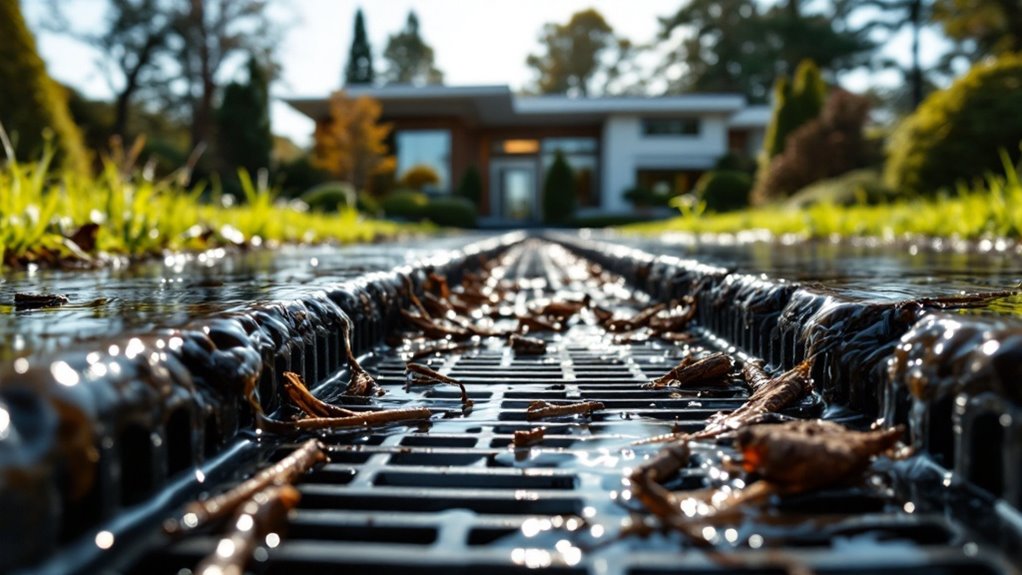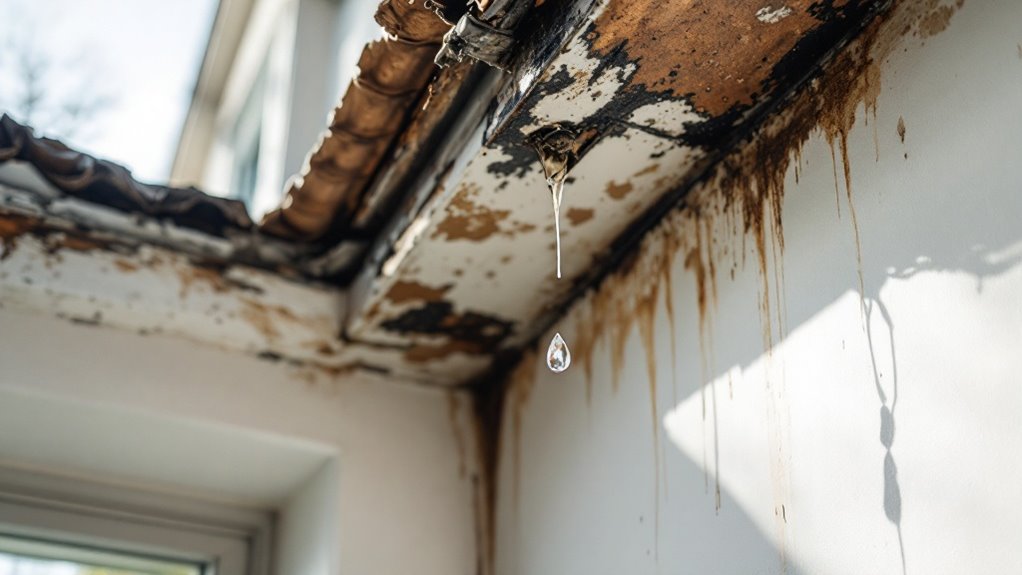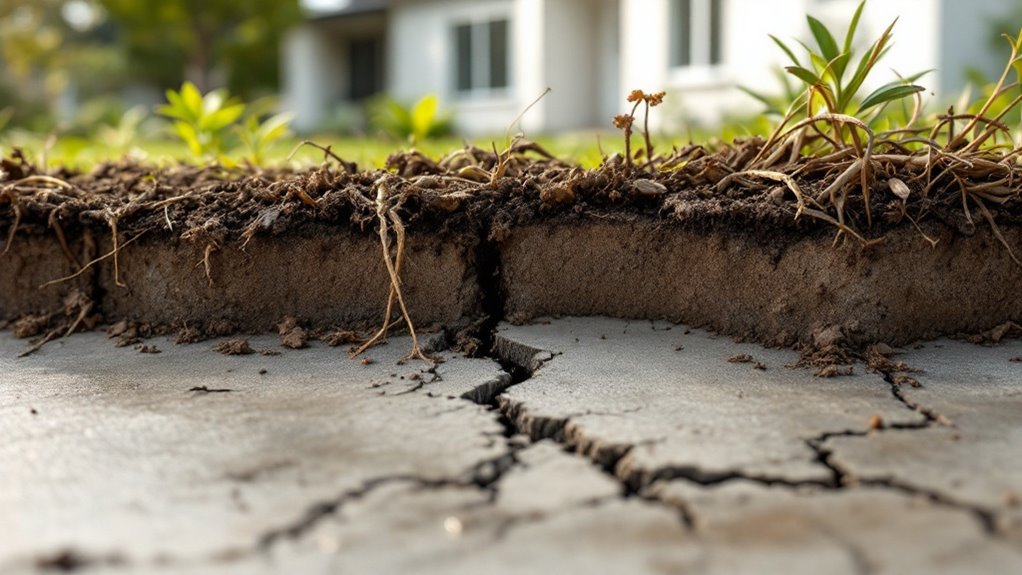Did you know that nearly 14% of newer homes experience water damage within the first few years of construction? This surprising statistic highlights a range of potential issues that can arise. From inadequate drainage systems to faulty plumbing installations, several factors can lead to significant damage. Understanding these causes is essential if you want to protect your investment and maintain a safe living environment. What might be lurking beneath the surface of your home?
Key Takeaways
- Inadequate drainage systems can lead to water pooling around the foundation, causing structural damage over time.
- Faulty plumbing installations may result in hidden leaks, leading to water damage and mold growth if not addressed promptly.
- Poorly installed windows and doors allow water infiltration during storms, damaging insulation and requiring costly repairs.
- Roof leaks from missing shingles or damaged flashing can cause significant water damage to ceilings and walls if not regularly inspected.
- High humidity levels can promote mold growth and damage various surfaces, necessitating proper ventilation and HVAC maintenance.
Inadequate Drainage Systems

When you’re living in a newer home, it’s easy to assume that everything’s built to last, but inadequate drainage systems can quickly lead to problems. If your home doesn’t have proper drainage, water can pool around the foundation, causing significant damage over time. Poorly positioned gutters or downspouts can likewise contribute, directing water toward your home instead of away from it. You might notice damp spots in your basement or mold growth, both signs that water isn’t being managed correctly. Regularly inspecting your drainage system and ensuring everything’s functioning as it should is essential. By addressing these issues early, you can prevent costly repairs down the line and maintain a dry, healthy environment in your home. Understanding effective drainage solutions is crucial for safeguarding your home from potential water damage.
Faulty Plumbing Installations
Faulty plumbing installations can lead to significant water damage in your home. If you notice improper pipe connections, inadequate sealing techniques, or low-quality materials, you might be at risk. Addressing these issues early can save you from costly repairs down the line. Additionally, understanding emergency plumbing costs can help you budget for potential repairs and avoid unexpected financial strain.
Improper Pipe Connections
Improper pipe connections can lead to significant water damage in newer homes, often resulting from rushed or careless plumbing installations. When pipes aren’t connected securely, leaks can develop, causing water to seep into walls, floors, and foundations. You might notice water stains or mold growth, indicators of hidden leaks. It’s essential to guarantee that all joints are fitted correctly and tightened to prevent these issues. Regular inspections can help catch potential problems before they escalate. If you’ve recently moved into a new home, consider having your plumbing checked by a professional. Taking these proactive steps can save you from costly repairs and extensive damage later on. Don’t underestimate the importance of proper pipe connections in maintaining your home’s integrity. Quick action during emergencies can help prevent additional costs associated with water damage.
Inadequate Sealing Techniques
While you might not think about sealing techniques during plumbing installations, inadequate sealing can lead to serious water damage in newer homes. When pipes aren’t properly sealed, even a small leak can escalate quickly, causing mold growth and structural damage. You’ll often find this issue in areas like joints and fittings, where water pressure may force leaks through poorly applied sealants. If you notice dampness or water stains around your fixtures, it’s vital to investigate immediately. Regular inspections can help catch these problems early, saving you from costly repairs down the line. Always verify your plumbing is handled by skilled professionals who prioritize effective sealing techniques to protect your home from potential water damage.
Low-Quality Materials Used
When you choose low-quality materials for plumbing installations, you’re setting the stage for potential water damage in your home. Cheap pipes and fittings can corrode, crack, or leak over time, leading to significant issues. For instance, inferior PVC pipes may not withstand high water pressure, resulting in bursts that can flood your space. Furthermore, low-grade sealants might fail, allowing moisture to seep into walls and floors. You may not notice the damage until it’s too late, causing costly repairs. Investing in high-quality materials guarantees better durability and reduces the risk of leaks, ultimately protecting your home from water damage. Remember, it’s often wiser to spend a bit more upfront than to face expensive consequences later on.
Poorly Installed Windows and Doors
Regardless of whether your home is newly built, poorly installed windows and doors can lead to significant water damage. When these openings aren’t sealed correctly, water can seep in during rainstorms or melting snow, creating a breeding ground for mold and mildew. You might notice drafts or condensation forming, which are telltale signs of improper installation. If water infiltrates your walls, it can damage insulation and lead to costly repairs. Regularly inspect your windows and doors for gaps or cracks, and guarantee they’re properly caulked. If you spot any issues, consider contacting a professional for repairs. By being proactive, you can help protect your home from potential water damage caused by these critical components.
Roof Leaks and Maintenance Issues

Roof leaks can quickly become a homeowner’s nightmare, especially in newer homes that may have overlooked maintenance. Even small issues, like missing shingles or damaged flashing, can lead to significant water damage if not addressed promptly. You might think your roof is in good shape, but regular inspections are essential to catch potential problems early. Clogged gutters can likewise contribute to leaks, as water backs up and seeps into your home’s structure. Make it a habit to check your roof after severe weather, ensuring everything remains intact. If you notice water stains on ceilings or walls, don’t wait—investigate immediately. Keeping up with roof maintenance not only prevents leaks but also extends the lifespan of your roof, saving you money in the long run.
High Humidity Levels
High humidity levels can silently wreak havoc in newer homes, leading to water damage that’s often overlooked. When moisture in the air rises above 60%, it creates an ideal environment for mold and mildew growth. You might notice musty odors or condensation on your windows, signs that humidity is too high. This excess moisture can damage walls, ceilings, and flooring, weakening the structure over time. Proper ventilation is key to controlling humidity levels, so verify your home has adequate airflow. Using dehumidifiers can likewise help maintain a comfortable environment. Regularly monitoring humidity levels with a hygrometer will empower you to take preventive measures before significant damage occurs. Staying proactive can save you time, money, and stress down the line.
Foundation and Soil Problems

Foundation and soil problems can lead to serious water damage in your home. If you have poor drainage systems or experience soil settlement issues, water might collect around your foundation, causing significant issues over time. It’s essential to address these problems early to protect your investment.
Poor Drainage Systems
When homes are built without proper consideration for drainage systems, you might find yourself facing significant water damage issues. Poor drainage can lead to water pooling around your foundation, increasing the risk of leaks and structural damage. If the soil around your home isn’t graded correctly, rainwater can flow toward the foundation instead of away from it. This excess moisture can weaken the foundation, leading to cracks and even flooding in your basement. Furthermore, downspouts that don’t direct water far enough from your home can intensify the problem. Regularly inspecting and maintaining your drainage systems is essential to preventing these issues. By ensuring proper drainage, you can protect your home from costly water damage and maintain its structural integrity.
Soil Settlement Issues
Improper drainage can lead to significant soil settlement issues, which pose further risks to your home’s stability. When water accumulates around your foundation, it can cause the soil beneath to shift or compress unevenly. This settling can create cracks in your walls, misaligned doors, and even structural damage over time. You might notice these issues worsening after heavy rains or rapid snowmelt, as excess moisture weakens the soil’s integrity. To combat this, verify your drainage systems are functioning properly, directing water away from your home. Regularly check for signs of settling, and address any drainage problems immediately. Taking these steps can help maintain your foundation’s integrity and, ultimately, your home’s safety.
Appliance Failures
Appliance failures are among the leading causes of water damage in newer homes, often catching homeowners off guard. When appliances malfunction, they can lead to significant leaks or even flooding, resulting in costly repairs. It’s crucial to be aware of common issues that can arise from household appliances:
- Washing machines: Hoses can crack or disconnect, causing water to spill onto your floor.
- Dishwashers: A failing seal or clogged drain can lead to leaks that go unnoticed.
- Water heaters: These can develop leaks over time, potentially leading to a major water event.
Regular maintenance and inspections can help prevent these issues, ensuring your home stays dry and damage-free. Stay proactive to protect your investment!
Landscaping and Grading Errors
Water damage doesn’t just come from inside your home; landscaping and grading errors can likewise create serious problems. When your yard slopes towards your house instead of away, rainwater can pool around your foundation. This excess moisture can lead to leaks and even foundation damage over time. Moreover, improper drainage systems, like clogged gutters or downspouts, can direct water back towards your home instead of away from it. If you’ve got heavy vegetation too close to your foundation, roots can disrupt the soil and further worsen drainage issues. To prevent these complications, it’s essential to assess your landscaping and guarantee proper grading. Taking these steps can save you costly repairs and keep your home dry and safe.
HVAC System Malfunctions
Although HVAC systems are designed to regulate temperature and humidity, malfunctions can lead to unexpected water damage in your home. When these systems fail, excess moisture can accumulate, creating an environment ripe for damage. Here are a few common issues:
- Clogged Drains: If the condensate drain gets blocked, water can back up and overflow, damaging ceilings and walls.
- Refrigerant Leaks: Low refrigerant levels can cause the evaporator coil to freeze, leading to water pooling when it thaws.
- Improper Installation: If your system isn’t set up correctly, it may not remove moisture effectively, contributing to mold growth.
Conclusion
Within the realm of newer homes, water damage can sneak up on you like a ninja in the night! You’ve got to stay vigilant against those sneaky drainage issues, plumbing blunders, and humidity villains. It’s a battle against mold and structural chaos! Regular inspections are your trusty shield, protecting your castle from the relentless tide of moisture. Don’t let your dream home turn into a soggy nightmare—take action today, and keep those water woes at bay!
